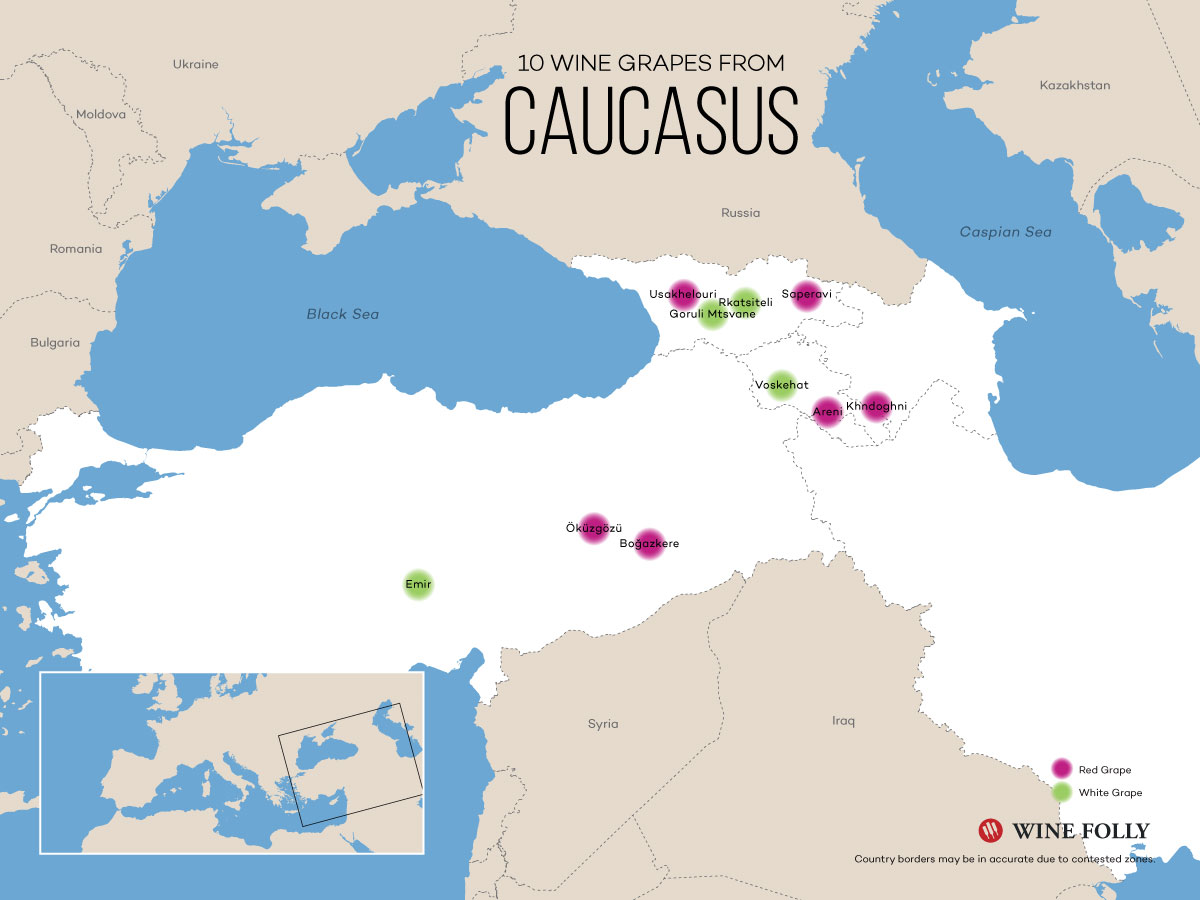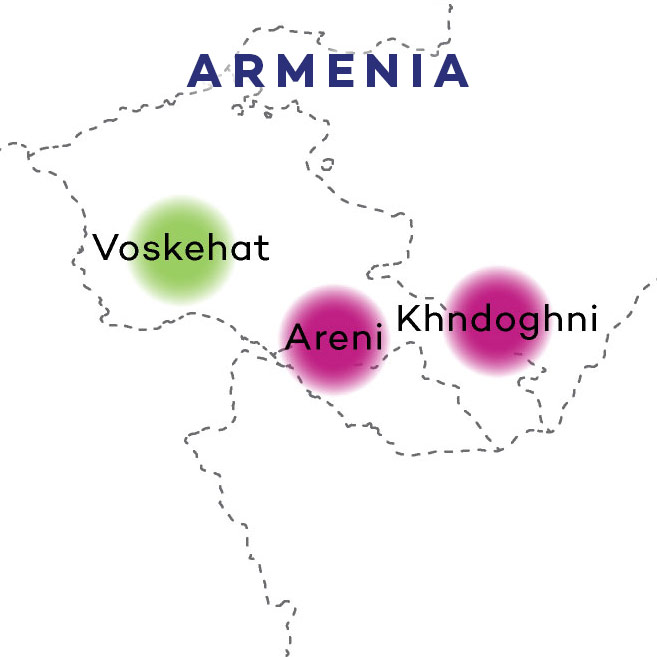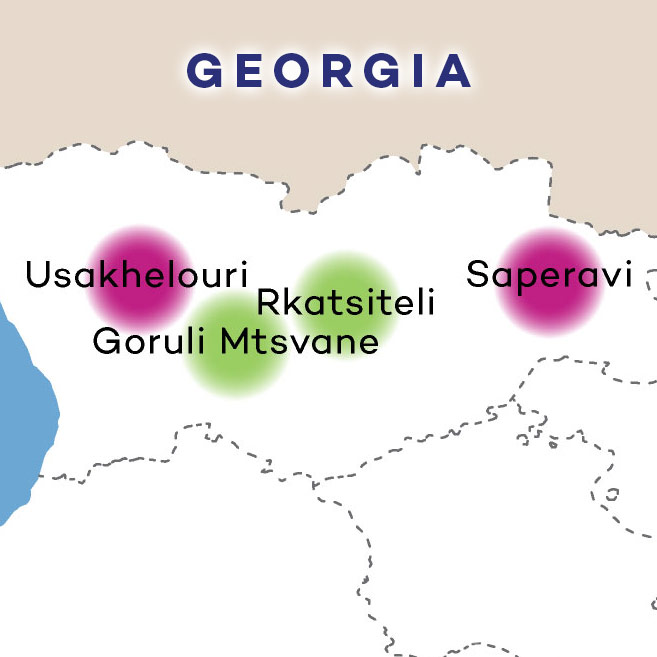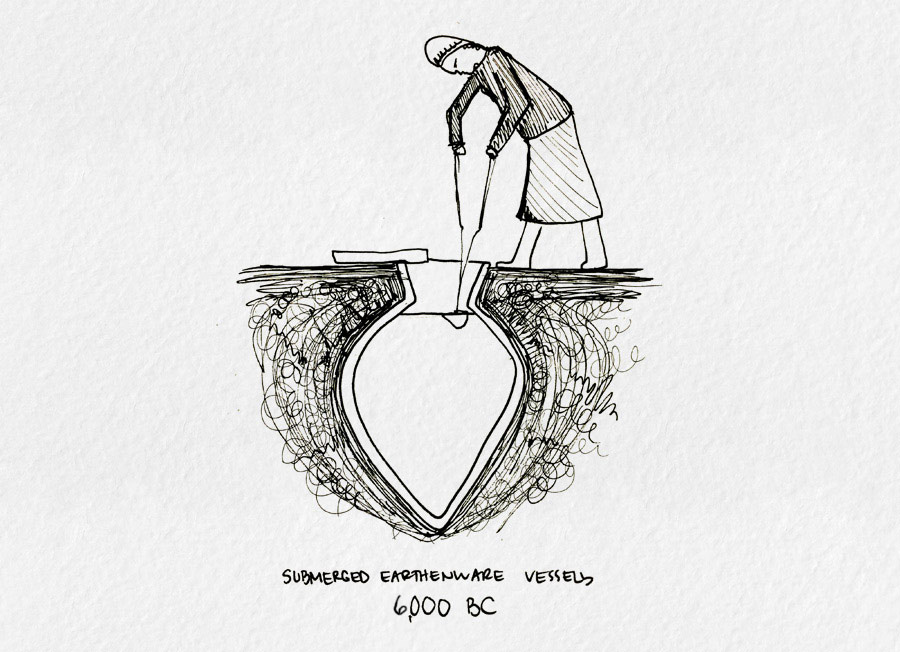The Caucasus region encompasses Armenia, Azerbaijan, Georgia, and parts of Iran, Russia, and Turkey. It is considered the birthplace of wine. Archaeologists have discovered the oldest winemaking facility in Armenia, grape residue in clay jars in Georgia, and signs of grape domestication in eastern Turkey—all dating back to between 8000 B.C. and 4100 B.C.
Today, the Caucasus is at it again. They’re making wines with rare and fascinating grapes, sometimes coupled with ancient techniques–and they’re good!

Of course, Caucasus is not your typical wine region. Remember that these countries may be next to one another, but they aren’t exactly best friends. The brutal war between Armenia and Azerbaijan in the 1990s is still causing political turmoil between the neighboring countries. Then, there’s Georgia’s mysterious moving border (there are now two contested border areas along the Russian-Georgian border).
To make wine in Caucasus is either insane or visionary…we think the latter.
To help us understand the wines of this area, we’ve invited the authors of Uncorking the Caucasus: Wines from Turkey, Armenia, and Georgia, who’ve traveled the region extensively, to highlight the best grapes to know.
10 Varieties to Look for from the Caucasus
Areni
“ah-reh-nee”
This red grape hails from a town of the same name in south Armenia. Because of geographical isolation and its harsh growing climate, it was never affected by phylloxera. Its thick skin protects it from the summer sun and the harsh, high-elevation continental climate. It makes red wine with a light hue, high clarity, fresh acidity, and soft tannins. Wines made from this grape can have sour cherry, herb, spice, and grassy flavors – which, at times, remind us of a cross between Pinot Noir and Sangiovese. The grape gained some international fame when Zorah Karasi, a varietal wine made from Areni, was featured in the list of Bloomberg’s Top Ten Wines of 2012.
Khndoghni
“khhhang-douhhh-nee”
The name Khndoghni is derived from the Armenian word “khind”, which means laughter. This is a native red wine variety from the controversial Nagorno-Karabakh area, which – depending on the source – is considered a region of Armenia, a separate nation, or a part of Azerbaijan. This grape has high tannins and offers interesting black and blue fruits, cotton candy, and earth characteristics. Wines made from this grape have grippy tannins, precise structure, and exhibit aging potential. Khndoghni is usually aged in Caucasian oak barrels sourced from the same area.
Voskehat
“voh-ski-hut”
If Areni is the signature red grape of Armenia, then Voskehat is the poster child of Armenian white wine. Voskehat translates to “golden seed.” It is a hardy and thick-skinned grape that gets along well with the hot summer and bitterly cold winter of the high Armenian Plateau. Almost all the winemakers in Armenia who make white wine use this grape, either in varietal wine form or in a blend. It makes smooth- and medium-bodied white wine with floral, savory, tropical fruit, and stonefruit notes.
Goruli Mtsvane
“guh-roo-lee Mtsva-nay”
This is a different variety from Mtsvane, which grows in almost every region in Georgia. Goruli Mtsvane means “green from Gori,” and Gori is a city in south-central Georgia. There’s also a possibility it also refers to the word “hill,” as “gori” relates to hills in Georgian. A late-ripening grape that oxidizes easily, only a few winemakers make wine from this rare variety. When made in the qvevri, it delivers one of the most interesting experiences in wine. Its high-toned aromas range from peach, lime, apricot, wildflower, pine, and nut. On the palate, the weighty body is reminiscent of a light red wine. Hunting down a Goruli Mtsvane wine can be challenging but also incredibly rewarding.
Rkatsiteli
“rah-kats-ee-teh-lee”
Rkatsiteli, meaning “red stem,” is a ubiquitous white wine variety comprising nearly half of Georgia’s vineyard plantings. It is a hardy and easy-to-grow grape as it is resistant to cold and maintains a high level of acidity and sugar as it ripens. It can be made into dry, semi-sweet, fortified wines, and brandy. This variety is treated in both the traditional Georgian qvevri style with extended skin contact and the conventional-style white wine technique. In the conventional style, it becomes a well-balanced, medium-bodied white wine with a touch of spice. When made in qvevri style, it takes on an amber tone, a forceful structure, and beautiful creaminess on the palate. What Chardonnay is for California, this grape is to Georgia.
Saperavi
“sah-per-ra-vee “
Saperavi means “color/dye.” This is the most widely planted red wine variety in Georgia. Like Alicante Bouschet, it is teinturier with red flesh and red juice. This dark-skinned and dark-fleshed grape makes deep red, inky, and often opaque wine with a heavy body and profound texture. Some wineries in the country label it as black wine instead of red. Due to the grape’s marked acidity and myriad characteristics of black fruit, licorice, chocolate, earth, smoked meat, tobacco, savory spice, and pepper, it is extremely versatile. It can be made into rosé, dry, semi-sweet, sweet, and fortified wines. A dry red Saperavi wine resembles a mix between Blaufrankisch and Syrah.
Usakhelouri
“oo-sa-khe-lo-uri”
Usakhelouri translates to “a grape with no name.” A native of western Georgia, this is an extraordinarily low-yielding and rare variety that grows on the slopes of the Greater Caucasus Mountains. The total annual harvest is only a few tons. It is grown in a few small, remote villages and can be made into dry red or naturally semi-sweet wine with a high price tag. The wines made from this variety are aromatic and velvety, with vibrant acidity and light tannins. The flavors are red fruit, purple flower, mint, pepper, and forest floor. The semi-sweet wine made from Usakhelouri is a wonderfully complex wine that reminds us of what Pinot Noir might taste like if made into a dessert wine.
Going Natural
Georgia has struck a chord with worldwide fans of natural and organic wines. The method of making wine in buried clay vessels known as qvevri (pronounced “kvev-ree”) in Georgia is a UNESCO-listed Intangible Heritage of Humanity and is Georgia’s claim to fame.
Boğazkere
“bow-ahz-keh-reh”
This grape is native to the Diyarbakir area in Southeast Turkey. It prefers to grow in a hot, dry climate at high altitudes. The name Boğazkere translates to “throat burner” – a possible reference to its strong tannins and medium acidity, reminiscent of Tannat. Boğazkere can be used as a blending grape and can also be made into a varietal wine. In varietal wine, it expresses notes of dark berry, pepper, dark chocolate, clove, eucalyptus, tobacco, and licorice.
Emir
“eh-meer”
Native to and grown exclusively in the famous Cappadocia region of Turkey, this grape thrives in high altitude, volcanic soil, and diurnal temperature variation (hot during the day and cool at night). Its name translates to “lord/ruler,” as the wine made from Emir was once a popular choice at the local lords’ tables. It produces a smooth and crisp white wine with a yellow-green hue. The flavor profile includes apple, yellow pear, pineapple, blood orange, kiwi, melon, and a touch of pine. Emir is often compared to Albarino and Pinot Grigio.
Öküzgözü
“ur-kuz-gur-zuh”
This grape is native to the Elazig area in Eastern Turkey. It likes hot, dry summers and cold winters, which matches up perfectly with the extreme continental climate of the Anatolian Plateau. The name means “ox eye,” which hints at its round and fleshy appearance. Öküzgözü has high acidity and floral aromas. The palate leans towards raspberry, plum, pomegranate, brown spice, and earthy flavors. The high acidity is what stands out the most in this grape. It is often blended with Boğazkere for added structure. On its own, it makes some memorable, fruit-forward wines.
Last Word: Go Find Some
Wines from all three countries are becoming more widely available worldwide. The wines to look out for are definitely the ones made with indigenous grapes. So, keep your eyes open for these names to experience a taste of this fascinating part of the world.
Some interesting related articles
Inside Georgia’s moving border
About winemaker from Zorah Wines



